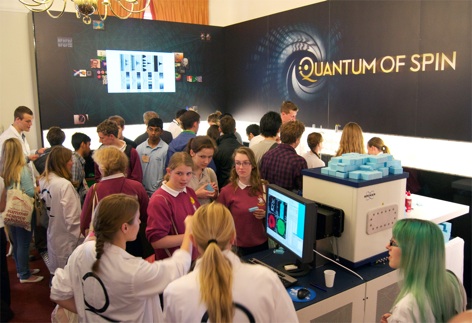On undoubtedly the wettest, most miserable Friday morning of what’s so far been a sodden summer, the normally-sedate rooms of the Royal Society are heaving. School trips, families, curious tourists and even the odd dripping journalist are making their way around 21 stands showcasing current research as part of this year’s Royal Society Summer Science Exhibition.
Interspersed with display cabinets containing some of the Society’s many treasures, visitors can see two-foot-tall robots playing football in the library; fruit flies in the council rooms as part of a display on healthy ageing; and an MRI scanner revealing the inside of different sorts of fruit.

There are displays from the National Physical Laboratory on the study and uses of bubbles; from the University of Manchester on how the Diamond Light Source is helping to discover what colour the first beaked bird’s feathers where when it flew 120 million years ago; and from the Science and Technology Facilities Research Council on how cosmic rays are being studied, up mountains and down mines, on the centenary of their discovery. There are displays on things very large and far away (the ALMA microwave telescope array, currently being built in Chile, whose dishes are mounted on trucks to improve the resolution of its images of the birth of planets and galaxies) and the very small (mini-motors based on the systems bacteria use to propel themselves around).
Engineering is, slightly disappointingly, rather in the background of all the displays, but it’s there, nonetheless. From the point of view of The Engineer it’d be good to bring it into the foreground a bit more, but seeing the enthusiasm of everyone involved, it seems churlish to raise the subject.
It’s always a heartening event, and one that I think is just as valuable for the participants as for the visitors. It’s a very active event: anyone who thinks young people are blank-faced video-game zombies would be well advised to spend a little time there and see just how much they’re getting involved. Everywhere you look there are people asking questions, with animated discussions forming in knots that spin away from the scientists on the stands.
The exhibitors are also getting a lot out of the event. The level of thought that’s gone into the displays is impressive, and the researchers are finding out a great deal about public engagement. It’s quite rare for them to be exposed to the public to this degree, as several people I spoke to agreed, and the difficulty of pitching your explanation to the right level becomes clear.
One young researcher from Manchester, enthusiastically explaining to me how X-ray fluroescence spectroscopy not only showed him how dark his prehistoric bird fossil’s feathers had been but also gave insights into how it might have behaved, told me that an X-ray physicist had brought his daughter in to see them. ‘He was asking me X-ray questions and she wanted to know about the fossil, so I had to keep relating one to the other,’ he told me. What was most surprising to many of the young people he spoke to was the number of different disciplines come to bear on his studies — paleontology, biology, chemistry, and particle physics — and how important it is to understand all of their contributions.
The Summer Science Exhibition only lasts a week, which is a bit of a shame. Do pop in over the weekend if you get the chance. Take the family, and go armed with questions. It won’t take much prompting to get a discussion going.










Water Sector Talent Exodus Could Cripple The Sector
Well let´s do a little experiment. My last (10.4.25) half-yearly water/waste water bill from Severn Trent was £98.29. How much does not-for-profit Dŵr...